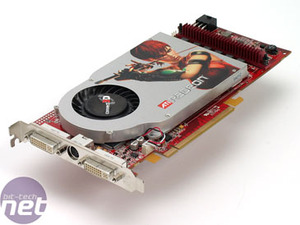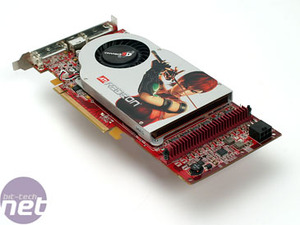At the end of last month, we got word from ATI that the massively delayed Radeon X1800XT had reached its end of life a mere five months after its initial availability. It was rumoured at the time that it would be replaced by a new addition Radeon X1900 family, the Radeon X1900GT. This suggestion was supported by the fact that this card was found on sale for $370 (around £250 including VAT) in the US last week. Some online retailers still stock Radeon X1800XTs and will continue to until stocks run dry. However, we now know that the Radeon X1900GT is ATI's X1800XT replacement.
It is designed to compete head-to-head with NVIDIA's GeForce 7900 GT and is expected to fit into the very attractive sub-£250 market. Enthusiasts are constantly looking for the best price-performance deal available on the market and that typically comes in the £200-250 price bracket. The cards that fit into this price range often have the same features as both NVIDIA and ATI's high end solutions, just with lower clock speeds. This allows enthusiasts to potentially get close-to-flagship performance for a fraction of the price after a bit of overclocking.
Will ATI's Radeon X1900GT prove to be a good competitor for the GeForce 7900 GT, or will ATI find it hard to match NVIDIA's current price-performance rocket? We have a look at two Radeon X1900GTs from Connect3D and Sapphire and put them through their paces. Let's find out whether Radeon X1900GT is the chosen one...
Memory Clock: 1200MHz
Connect3D sells its cards as 'barebones', meaning that there are no games included. Many enthusiasts users aren't interested in paying extra for bundled games and are just looking for the best price on the hardware that they're interested in. Connect3D makes a lot of sales to this type of user. Other ATI partners offer a premium bundle with high-end video cards and as a result are often beaten on price by partners like Connect3D.



ATI and its partners seem undecided about the naming of this SKU...Connect3D's Radeon X1900GT has a new cooling design. Ok, so it's not completely new, as it is very similar to the one on the Radeon X1800XL, Radeon X1800GTO and also Sapphire's Radeon X1900GT. The heatsink is predominantly copper underneath the aluminium shell. The fin density is a less than the older cooler design but it benefits from a larger fan that spins more slowly. Along with that, the variable speed adjustment appears to have better temperature thresholds for adjusting the fan speed.
This is definitely an improvement on the cooling solution that was on the two single-slot Radeon X1800 SKUs. It is worth mentioning that the fan does still spin up during heavy gaming, but the pitch appears to remain consistent. It seems that ATI has finally managed to make its single slot X1800/X1900-series cooler design stay at a constant pitch in both 2D and 3D modes rather than constantly throttling up and down.
Interestingly, the sticker in the bottom left hand corner of the board says that the card is an X1900GTO PCIE 256M. It seems that ATI and its partners were undecided on the product's name, almost as if it wasn't decided until after the cards had been shipped into retail boxes. Sapphire's Radeon X1900GT has the same sticker as well, although Sapphire has added its own product identification sticker in the opposite corner.

 The PCB layout is typical of both Radeon X1800 and Radeon X1900-series cards. It comes with eight 32MB Samsung BC14 GDDR3 DRAM modules (totalling 256MB) clocked at 600MHz (1200MHz DDR). The modules are actually rated to 1430MHz DDR, based on the fact that they are 1.4ns DRAM chips.
The PCB layout is typical of both Radeon X1800 and Radeon X1900-series cards. It comes with eight 32MB Samsung BC14 GDDR3 DRAM modules (totalling 256MB) clocked at 600MHz (1200MHz DDR). The modules are actually rated to 1430MHz DDR, based on the fact that they are 1.4ns DRAM chips.
The R580 core has 12 of its 48 pixel shader processors disabled - the equivalent of a single pixel shader quad - meaning that there are a total of 36 pixel shader processor units enabled. Also, there are only 12 of the 16 pixel output engines turned on. However, ATI has chosen to leave all sixteen texture units enabled. While the texture units are decoupled from the shader units (there are three shader units enabled on Radeon X1900GT), they are still configured in blocks of four texture units per shader unit.
This means that the texture units are not completely separate from the pixel shader processors. With only three of the four shader units enabled on the Radeon X1900GT, the 36 pixel shader processors are only able to address 12 of the 16 texture units that are turned on. Obviously, this means that the hardware still keeps its 3:1 shader-to-texture ratio. Looking at the core configuration, the limiting factor on the Radeon X1900GT is likely to be fill rate.

 As already mentioned, Connect3D's bundle is a sparse one. The box is almost exactly the same one as the company used for its Radeon X1900XTX card minus a sticker. The cable assortment is also similar too.
As already mentioned, Connect3D's bundle is a sparse one. The box is almost exactly the same one as the company used for its Radeon X1900XTX card minus a sticker. The cable assortment is also similar too.
The card has VIVO functionality and the assortment includes a combi cable featuring S-Video In, S-Video Out, Composite In and Composite Out. There is also a 6-pin power adapter, a YPbPr component out cable and two DVI-to-VGA convertors to round off the bundle. Incidentally, there was no driver CD or manual included in the box. We hope that this isn't a trend because Connect3D's Radeon X1900XTX sample we were sent came without a 6-pin PCI-Express power adapter. However, the company assures us that this is because the card that we were sent was the first sample in the country.
The box was packed better than the Radeon X1900XTX we recieved, as there is a piece of foam both above and below the card to protect it. The Radeon X1900XTX we were sent only had a single piece of foam below the card, meaning that the card could be subject to damage during shipping.
It is designed to compete head-to-head with NVIDIA's GeForce 7900 GT and is expected to fit into the very attractive sub-£250 market. Enthusiasts are constantly looking for the best price-performance deal available on the market and that typically comes in the £200-250 price bracket. The cards that fit into this price range often have the same features as both NVIDIA and ATI's high end solutions, just with lower clock speeds. This allows enthusiasts to potentially get close-to-flagship performance for a fraction of the price after a bit of overclocking.
Will ATI's Radeon X1900GT prove to be a good competitor for the GeForce 7900 GT, or will ATI find it hard to match NVIDIA's current price-performance rocket? We have a look at two Radeon X1900GTs from Connect3D and Sapphire and put them through their paces. Let's find out whether Radeon X1900GT is the chosen one...
Connect3D Radeon X1900GT 256MB
Core Clock: 575MHzMemory Clock: 1200MHz
Connect3D sells its cards as 'barebones', meaning that there are no games included. Many enthusiasts users aren't interested in paying extra for bundled games and are just looking for the best price on the hardware that they're interested in. Connect3D makes a lot of sales to this type of user. Other ATI partners offer a premium bundle with high-end video cards and as a result are often beaten on price by partners like Connect3D.



ATI and its partners seem undecided about the naming of this SKU...
This is definitely an improvement on the cooling solution that was on the two single-slot Radeon X1800 SKUs. It is worth mentioning that the fan does still spin up during heavy gaming, but the pitch appears to remain consistent. It seems that ATI has finally managed to make its single slot X1800/X1900-series cooler design stay at a constant pitch in both 2D and 3D modes rather than constantly throttling up and down.
Interestingly, the sticker in the bottom left hand corner of the board says that the card is an X1900GTO PCIE 256M. It seems that ATI and its partners were undecided on the product's name, almost as if it wasn't decided until after the cards had been shipped into retail boxes. Sapphire's Radeon X1900GT has the same sticker as well, although Sapphire has added its own product identification sticker in the opposite corner.


The R580 core has 12 of its 48 pixel shader processors disabled - the equivalent of a single pixel shader quad - meaning that there are a total of 36 pixel shader processor units enabled. Also, there are only 12 of the 16 pixel output engines turned on. However, ATI has chosen to leave all sixteen texture units enabled. While the texture units are decoupled from the shader units (there are three shader units enabled on Radeon X1900GT), they are still configured in blocks of four texture units per shader unit.
This means that the texture units are not completely separate from the pixel shader processors. With only three of the four shader units enabled on the Radeon X1900GT, the 36 pixel shader processors are only able to address 12 of the 16 texture units that are turned on. Obviously, this means that the hardware still keeps its 3:1 shader-to-texture ratio. Looking at the core configuration, the limiting factor on the Radeon X1900GT is likely to be fill rate.


The card has VIVO functionality and the assortment includes a combi cable featuring S-Video In, S-Video Out, Composite In and Composite Out. There is also a 6-pin power adapter, a YPbPr component out cable and two DVI-to-VGA convertors to round off the bundle. Incidentally, there was no driver CD or manual included in the box. We hope that this isn't a trend because Connect3D's Radeon X1900XTX sample we were sent came without a 6-pin PCI-Express power adapter. However, the company assures us that this is because the card that we were sent was the first sample in the country.
The box was packed better than the Radeon X1900XTX we recieved, as there is a piece of foam both above and below the card to protect it. The Radeon X1900XTX we were sent only had a single piece of foam below the card, meaning that the card could be subject to damage during shipping.

MSI MPG Velox 100R Chassis Review
October 14 2021 | 15:04







Want to comment? Please log in.